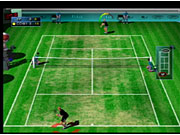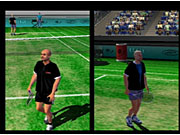When you talk about tennis video games, it's difficult to not bring up Sega's Virtua Tennis franchise. There's plenty of reason for this as Virtua Tennis was the first modern offering to introduce the idea of a tennis video game to a broad audience, and it did so with almost impeccable form. Virtua Tennis has also been mimicked by just about every game on the market, though none have been able to equal the experience that it provided--let alone surpass it. Dreamcatcher's Agassi Tennis Generation is yet another one of these Virtua Tennis imitators. Its short list of options, buggy gameplay, and generally tepid presentation prevent it from being anywhere near as enjoyable as the game it's trying to emulate.

As you might infer from the game's title, Agassi Tennis Generation lets you play as pro tennis player Andre Agassi, though you can also play as one of 31 other pro male tennis players. The three different modes of play available in Agassi Tennis Generation--quick match, arcade, and tournament--are all fundamentally the same. Quick match is a one-off game that lets you choose your player, your opponent, the court surface, and, if you choose to play a doubles match, your partner. Arcade mode only lets you choose your player, then runs you through a series of random opponents. Finally, tournament mode puts you through a series of ten different tournaments as Andre Agassi. This pretty much covers the bare minimum of what you'd expect from a tennis game. Though more options might have made Agassi Tennis Generation a more appealing package, the game's haphazard gameplay mechanics keep any additional modes of play from really making a difference.
The basic gameplay functions as you'd expect. There's a rising power meter to gauge the strength of your serve. You can execute lobs, top spin shots, slice shots, and standard (flat) shots using the face buttons. You can also influence the direction of your shots right before you make contact with the ball. However, the problems with the gameplay in Agassi Tennis Generation lie in the details. For starters, it's virtually impossible to make a shot while in motion. So if you're moving toward where the ball will be, and you try to start a swing before coming to a stop, the game will just ignore that button press. This is most likely just a symptom of the fact that the game actually anticipates where the ball is going and moves your character slightly. Interestingly, the game even initiates the animation of your swing before you ever touch the controller. This makes it feel as if you're not even playing the game. Compound these issues with cheap, simplistic AI, and you've stripped out most of the fun from a formula that's otherwise pretty sound.
The underlying machinations of Agassi Tennis Generation aren't so sharp, nor is the game's exterior. The game is played from a generally-static 3/4 camera angle above the court--though you can choose to play from a more-visceral but less-functional behind-the-back angle as well. Each has its pros and cons. The wide angle forces you to play on the back court every other set, while the behind-the-back angle doesn't give you a broad enough view of the court. The court surfaces look fine, as do the player animations. The player models are blocky and blurry and hardly resemble their real-life counterparts. Cast shadows are even worse, as they are even chunkier than the player models. Aside from this, there aren't really any glaring faults with the graphics. They're just very mediocre.

The game's sound design is pretty stripped-down, and much of it is handled rather poorly. Regardless of the court surface, the players' shoes squeak, and when the ball hits the court it sounds as though you're playing on a freshly waxed hardwood floor. There's a scorekeeper who just gives the basic scoring info. There's also a color commentator who has a habit of steamrolling right over the scorekeeper with vague, useless quips about the action. Considering the limited number of phrases he has, the game would've been better without the color commentary. The only competently-handled sounds in the game are the grunts made by players after hitting their strokes.
For such a relatively niche sport, there's a peculiarly large number of tennis video games on the market. Though none of the current batch have surpassed the quality of Sega's Virtua Tennis, the majority of them are better than Agassi Tennis Generation.